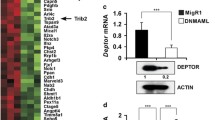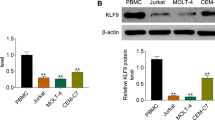Abstract
Membrane-associated guanylate kinase with inverted orientation protein 1 (MAGI-1) is a cytoplasmic scaffold protein that interacts with various signaling molecules; it negatively controls the cell growth of various types of cells and positively controls cell–cell interaction. In T cells, MAGI-1 has been shown to inhibit Akt activity through its interaction with PTEN and MEK1. In this study we found that MAGI-1 expression is decreased in multiple (9 out of 15) human T-cell leukemia cell lines, including adult T-cell leukemia (ATL), T-cell acute lymphoblastic leukemia and chronic T-cell lymphocytic leukemia. The overexpression of MAGI-1 protein in a MAGI-1-low ATL cell line reduced cellular growth. While the overexpression of MAGI-1 protein in a MAGI-1-low ATL cell line reduced the Akt and MEK activities, the knockdown of MAGI-1 in a MAGI-1-high ATL cell line augmented the Akt and MEK activities. Collectively, the findings of the present study suggest that the decreased expression of MAGI-1 in human T cells contributes to the development of several types of T-cell leukemia, partly through the stimulation of the Akt and MEK pathways.




Similar content being viewed by others
References
Dobrosotskaya I, Guy RK, James GL. MAGI-1, a membrane-associated guanylate kinase with a unique arrangement of protein–protein interaction domains. J Biol Chem. 1997;272(50):31589–97.
Valiente M, Andres-Pons A, Gomar B, Torres J, Gil A, Tapparel C, et al. Binding of PTEN to specific PDZ domains contributes to PTEN protein stability and phosphorylation by microtubule-associated serine/threonine kinases. J Biol Chem. 2005;280(32):28936–43.
Zmajkovicova K, Jesenberger V, Catalanotti F, Baumgartner C, Reyes G, Baccarini M. MEK1 is required for PTEN membrane recruitment, AKT regulation, and the maintenance of peripheral tolerance. Mol Cell. 2013;50(1):43–55.
Latorre IJ, Roh MH, Frese KK, Weiss RS, Margolis B, Javier RT. Viral oncoprotein-induced mislocalization of select PDZ proteins disrupts tight junctions and causes polarity defects in epithelial cells. J Cell Sci. 2005;118(Pt 18):4283–93.
Bangham CR, Ratner L. How does HTLV-1 cause adult T-cell leukaemia/lymphoma (ATL)? Curr Opin Virol. 2015;14:93–100.
Yasunaga J, Matsuoka M. Leukemogenesis of adult T-cell leukemia. Int J Hematol. 2003;78(4):312–20.
Matsuoka M, Yasunaga J. Human T-cell leukemia virus type 1: replication, proliferation and propagation by Tax and HTLV-1 bZIP factor. Curr Opin Virol. 2013;3(6):684–91.
Akagi T, Ono H, Nyunoya H, Shimotohno K. Characterization of peripheral blood T-lymphocytes transduced with HTLV-I Tax mutants with different trans-activating phenotypes. Oncogene. 1997;14(17):2071–8.
Higuchi M, Fujii M. Distinct functions of HTLV-1 Tax1 from HTLV-2 Tax2 contribute key roles to viral pathogenesis. Retrovirology. 2009;6:117.
Currer R, Van Duyne R, Jaworski E, Guendel I, Sampey G, Das R, et al. HTLV tax: a fascinating multifunctional co-regulator of viral and cellular pathways. Front Microbiol. 2012;3:406.
Makokha GN, Takahashi M, Higuchi M, Saito S, Tanaka Y, Fujii M. Human T-cell leukemia virus type 1 Tax protein interacts with and mislocalizes the PDZ domain protein MAGI-1. Cancer Sci. 2013;104(3):313–20.
Iwanaga Y, Tsukahara T, Ohashi T, Tanaka Y, Arai M, Nakamura M, et al. Human T-cell leukemia virus type 1 tax protein abrogates interleukin-2 dependence in a mouse T-cell line. J Virol. 1999;73(2):1271–7.
Tsubata C, Higuchi M, Takahashi M, Oie M, Tanaka Y, Gejyo F, et al. PDZ domain-binding motif of human T-cell leukemia virus type 1 Tax oncoprotein is essential for the interleukin 2 independent growth induction of a T-cell line. Retrovirology. 2005;2:46.
Yamada Y, Sugahara K, Tsuruda K, Nohda K, Hata T, Maeda T, et al. Fas-resistance in ATL cell lines not associated with HTLV-I or FAP-1 production. Cancer Lett. 1999;147(1–2):215–9.
Hori T, Uchiyama T, Tsudo M, Umadome H, Ohno H, Fukuhara S, et al. Establishment of an interleukin 2-dependent human T cell line from a patient with T cell chronic lymphocytic leukemia who is not infected with human T cell leukemia/lymphoma virus. Blood. 1987;70(4):1069–72.
Higuchi M, Tsubata C, Kondo R, Yoshida S, Takahashi M, Oie M, et al. Cooperation of NF-kappaB2/p100 activation and the PDZ domain binding motif signal in human T-cell leukemia virus type 1 (HTLV-1) Tax1 but not HTLV-2 Tax2 is crucial for interleukin-2-independent growth transformation of a T-cell line. J Virol. 2007;81(21):11900–7.
Yasunaga J, Matsuoka M. Leukaemogenic mechanism of human T-cell leukaemia virus type I. Rev Med Virol. 2007;17(5):301–11.
Zaric J, Joseph JM, Tercier S, Sengstag T, Ponsonnet L, Delorenzi M, et al. Identification of MAGI1 as a tumor-suppressor protein induced by cyclooxygenase-2 inhibitors in colorectal cancer cells. Oncogene. 2012;31(1):48–59.
Freeburn RW, Wright KL, Burgess SJ, Astoul E, Cantrell DA, Ward SG. Evidence that SHIP-1 contributes to phosphatidylinositol 3,4,5-trisphosphate metabolism in T lymphocytes and can regulate novel phosphoinositide 3-kinase effectors. J Immunol. 2002;169(10):5441–50.
Yoshita M, Higuchi M, Takahashi M, Oie M, Tanaka Y, Fujii M. Activation of mTOR by human T-cell leukemia virus type 1 Tax is important for the transformation of mouse T cells to interleukin-2-independent growth. Cancer Sci. 2012;103(2):369–74.
Higuchi M, Takahashi M, Tanaka Y, Fujii M. Downregulation of proapoptotic Bim augments IL-2-independent T-cell transformation by human T-cell leukemia virus type-1 Tax. Cancer Med. 2014;3(6):1605–14.
Feng X, Jia S, Martin TA, Jiang WG. Regulation and involvement in cancer and pathological conditions of MAGI1, a tight junction protein. Anticancer Res. 2014;34(7):3251–6.
Kranjec C, Massimi P, Banks L. Restoration of MAGI-1 expression in human papillomavirus-positive tumor cells induces cell growth arrest and apoptosis. J Virol. 2014;88(13):7155–69.
Zhang G, Liu T, Wang Z. Downregulation of MAGI1 associates with poor prognosis of hepatocellular carcinoma. J Investig Surg. 2012;25(2):93–9.
Zhang G, Wang Z. MAGI1 inhibits cancer cell migration and invasion of hepatocellular carcinoma via regulating PTEN. Zhong Nan Da Xue Xue Bao Yi Xue Ban. 2011;36(5):381–5.
Nakahata S, Ichikawa T, Maneesaay P, Saito Y, Nagai K, Tamura T, et al. Loss of NDRG2 expression activates PI3K–AKT signalling via PTEN phosphorylation in ATLL and other cancers. Nat Commun. 2014;5:3393.
Kataoka K, Nagata Y, Kitanaka A, Shiraishi Y, Shimamura T, Yasunaga J, et al. Integrated molecular analysis of adult T cell leukemia/lymphoma. Nat Genet. 2015;47(11):1304–15.
Kotelevets L, Van Hengel J, Bruyneel E, Mareel M, Van Roy F, Chastre E. Implication of the MAGI-1b/PTEN signalosome in stabilization of adherens junctions and suppression of invasiveness. FASEB J. 2005;19(1):115–7.
Humbert P, Russell S, Richardson H. Dlg, Scribble and Lgl in cell polarity, cell proliferation and cancer. Bioessays: News Rev Mol Cell Dev Biol. 2003;25(6):542–53.
Frese KK, Latorre IJ, Chung SH, Caruana G, Bernstein A, Jones SN, et al. Oncogenic function for the Dlg1 mammalian homolog of the Drosophila discs-large tumor suppressor. EMBO J. 2006;25(6):1406–17.
Acknowledgements
The authors thank Hiroyuki Miyoshi and Yasuaki Yamada for providing us with the lentiviral vector system and ATL cell lines, respectively. We thank Takeda Pharmaceutical Company for providing recombinant human IL-2. We also express our gratitude to Misako Tobimatsu for providing technical assistance. This work was supported in part by a grant-in-aid from the Ministry of Education, Culture, Sports, Science and Technology of Japan.
Author information
Authors and Affiliations
Corresponding author
Ethics declarations
Funding
Funding was supported by JSPS KAKENHI Grant Numbers (15H04704, 16K15502).
Conflict of interest
The authors declare no conflicts of interest.
About this article
Cite this article
Kozakai, T., Takahashi, M., Higuchi, M. et al. MAGI-1 expression is decreased in several types of human T-cell leukemia cell lines, including adult T-cell leukemia. Int J Hematol 107, 337–344 (2018). https://doi.org/10.1007/s12185-017-2359-1
Received:
Revised:
Accepted:
Published:
Issue Date:
DOI: https://doi.org/10.1007/s12185-017-2359-1




